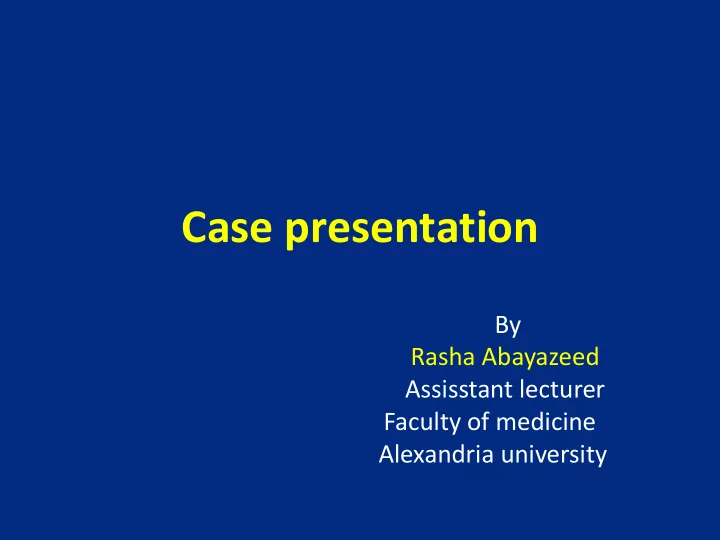

Case presentation By Rasha Abayazeed Assisstant lecturer Faculty of medicine Alexandria university
• A 47 year old male patient. • No Hx of DM nor hypertension. • Heavy smoker (30 pack-year smoking index) . • The patient suffered inferior STEMI 5 months ago (non-revascularized due to late presentation). • Echocardiography: No resting RWMA, EF: 66%. • Coronary angiography was done 1 week after the MI.
• Coronary aniography : LM: normal LAD: normal LCx: normal. RCA: totally occluded after the RV branch and receiving retrograde collaterals from the left system. .Recommendation: For trial PCI RCA that was attempted 2 months later but unfortunately failed and the final recommendation was for optimal medical treatment.
• Despite medical treatment, the patient still suffered from CSA CCS II-III, so he was referred for myocardial perfusion imaging for risk stratification.
• Gated exercise Technetium-99M SESTA MIBI SPECT study was done: Peak exercise Resting Heart rate (bpm) 80 140 (80% APTHR) Blood pressure (mmHg) 150/80 160/80 Exercise time 9 min Load 10.1 mets Symptoms chest pain and dyspnea ECG changes Q waves and inverted T No significant ECG waves in the inferior leads changes
T.A.Z M.M.A
M.M.A T.A.Z
Despite equivocal stress ECG of this patient, his myocardial perfusion scan showed High risk CAD
• 2014 ESC guidelines on the myocardial revascularization: • In patients presenting days after the acute event with a completed myocardial infarction and totally occluded infarct related artery, only those with recurrent angina or documented residual ischaemia — and proven viability on non- invasive imaging in a large myocardial territory — may be considered for revascularization. • Infarct related artery was occluded for about 5 months after the acute event chronic totally occluded artery
• Chronic total occlusion (CTO): • These are lesions with thrombolysis in myocardial infarction (TIMI) 0 flow for ≥ 3 months. • The prevalence of CTO in patients undergoing coronary angiography varies, ranging between 18% and 52% depending on the clinical profile of the patient being examined. • Patients with CTO usually have collaterization of the distal vessel on coronary angiography, but these collaterals may not provide sufficient blood flow to the myocardial bed resulting in ischemia and anginal symptoms.
• Current data suggest that successful percutaneous coronary intervention (PCI) for CTO is associated with improvement in patient symptoms, quality of life, left ventricular function, decreased risk for arrhythmia and improved survival, compared with those with unsuccessful CTO PCI. • However, all the scientific evidence supporting this treatment comes from observational studies, and no randomized study comparing percutaneous treatment with medical treatment has yet been published. • Attempts at CTO PCI remain infrequent (low procedural success, prolonged procedural time, increased procedural complications, and paucity of widespread expertise in the advanced techniques required to successfully treat these lesions). • Patients with coronary CTOs are often referred for coronary artery bypass graft surgery (CABG), but PCI is the preferred mode of revascularization for some patients, especially those with prior CABG and those with isolated right coronary artery CTO.
• Specific recommendations on the treatment of CTO in 2012 ACCF/SCAI/STS Appropriate use criteria for coronary revascularization focused update:
Considering the patient symptoms, his high risk MPI and isolated right coronary artery CTO Another trial of PCI RCA by an experienced operator in addition to extensive medical treatment
Take Home Message • In STEMI patients presenting late after the acute event with a completed myocardial infarction and occluded infarct related artery, non invasive imaging test is recommended to document the presence of residual ischemia and assess viability before considering revascularization. • In patients with CTO, treatment decision should be based on several factors including the patient symptoms, the need and feasibility of revascularization as well as the prognostic factors. • Myocardial perfusion imaging is an important modality for : .Risk stratification among patients with CAD. .Evaluation of extent, severity& location of ischemia as well as assessment of viability.
THANK YOU
Recommend
More recommend